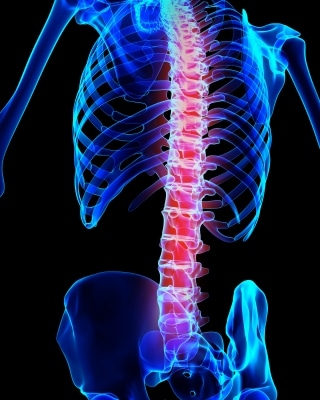
Spondyloarthritis (also known as spondyloarthropathy) is a diagnostic term that encompasses a range of inflammatory conditions involving the joints. The term literally means arthritis of the spine, and indeed back pain is the most common symptom, however the peripheral joints (i.e. arms, hands, legs and feet) can also be affected. Recent classification criteria separate the term into axial and peripheral forms.
This refers to chronic inflammation that affects mainly the axial skeleton – i.e. the entire spine, pelvis, rib cage and skull. The main diagnostic criteria are chronic (inflammatory) back pain (>3 months) with age of onset ≤45 years. Spinal mobility may be compromised if the disease progresses.

Axial spondyloarthritis may be detected by X-ray when structural bony damage or abnormalities have developed. In early or milder cases, where there is no detectable structural damage, diagnosis relies solely on physical examination and clinical or laboratory test results. A blood test (i.e. CRP and/or ESR/SED rate) will usually be performed to assess inflammation. MRI may be able to detect early signs, such as bone inflammation, bone marrow changes and oedema (excess fluid).
Ankylosing Spondylitis is a form of axial spondyloarthritis that typically starts in the spine or pelvis and that may spread to the neck or affect other joints. Sacroiliitis (inflammation of the sacroiliac joint/s – between the lower spine and pelvis) is a common first symptom. This may cause vertebrae to fuse as a result of new bone formation. Diagnosis requires the presence of inflammatory back pain and/or restricted spinal mobility, with worse pain and symptoms in the morning or after rest that are relieved with exercise.
Peripheral spondyloarthritis predominantly affects the peripheral joints, such as the arms, hands, legs or feet, in the form of arthritis or enthesitis (inflammation of the site where a ligament or tendon attaches to bone) or dactylitis (inflammation of the finger or toe joints). The patient may or may not have a history of inflammatory back pain. This form is typically associated with swelling in the arms and/or legs, but is more common in lower limbs.
This type of spondyloarthritis will be accompanied by at least one additional condition or feature of spondyloarthritis, such as sacroiliitis, osteoporosis, inflammatory bowel disease, psoriasis and/or uveitis (inflammation of the eye).
Numerous factors contribute to the development of spondyloarthritis: genetic, inflammatory and environmental factors. Interactions between these factors can lead to autoinflammation and autoimmunity and ultimately to the development of spondyloarthritis.
Spondyloarthritis has a significant genetic component. Numerous genes and variations in the genetic sequence have been identified that may contribute to the disease (especially ankylosing spondylitis).
One of the most strongly associated genetic factors is human leukocyte antigen B27 (HLA-B27). HLA genes encode cell-surface proteins with important immune functions. They allow the immune system to differentiate self-tissue from foreign cells or substances (antigens) and are associated with a number of autoimmune or autoinflammatory conditions. HLA-B27 can cause the immune system to attack healthy cells and tissue. An epidemiological study found that 75% of spondyloarthritis patients are HLA-B27 positive, compared to 7% of healthy controls. HLA-B27 is said to impose a nearly 40x increased risk of developing spondyloarthritis. A blood test can identify its presence.
Numerous other genes and their products have been implicated, mainly in ankylosing spondylitis, most of which have roles in immune regulation and/or inflammation. Amongst these are interleukins, which are proteins secreted by cells that are particularly important in stimulating the immune response and inflammation.
Various studies have found increased levels of immune cells (i.e. innate lymphoid cells, monocytes and certain T-cells) and/or inflammatory mediators (especially interleukins) in spondyloarthropathies.
Inflammation of the gut has also been implicated. An imbalance in gut microbiota may affect the intestinal immune response and lead to widespread inflammation. Disturbance to gut barriers (i.e. inflammatory bowel disease) or skin barriers (i.e. psoriasis) and microbial infection appear to be of relevance to the development of spondyloarthritis.
Other risk factors include:
Typically, the first line of treatment for both classes of spondyloarthritis is with non-steroidal anti-inflammatory drugs (NSAIDs). NSAIDs may reduce pain and inflammation and improve mobility in patients with spondyloarthritis. There is high quality evidence that both traditional, non-selective NSAIDs (i.e. ibuprofen, naproxen, diclofenac) and COX-2 specific inhibitor NSAIDs (i.e. celecoxib) are effective and safe.
Disease-modifying anti-rheumatic drugs (DMARDs) may be trialled if NSAIDs are unhelpful. DMARDs are designed to treat the underlying issues and may relieve arthritis symptoms and prevent joint damage. There are synthetic and biological forms. Conventional DMARDs are recommended for treatment of peripheral spondyloarthritis and include methotrexate, fasalazine and leflunomide. They are not particularly effective for axial spondyloarthritis, in which biological DMARDs are recommended.
Inhibitors of tumor necrosis factor alpha (TNFα) (i.e. etanercept, infliximab) are biological DMARDs. TNFα plays a major role in regulating the inflammatory (immune) response and is therefore a useful target in conditions involving immune dysregulation. TNFα inhibitors are highly effective in both spinal and peripheral arthritis and are strongly recommended for the treatment of ankylosing spondylitis. Unfortunately, however, they are expensive and associated with an increased risk of serious infections. They are therefore not recommended for all patients.
Corticosteroid injections may provide relief of localised pain and swelling, particularly for acute ankylosing spondylitis, sacroiliitis and peripheral spondyloarthritis. They are generally associated with a poor side effect profile, with serious adverse effects associated with long term use. There is limited support for their effectiveness in the long term.
It is important to exercise in order to maintain joint and cardiovascular health. Physical therapy is strongly recommended for spondyloarthritis, especially ankylosing spondylitis, as it prevents joint stiffness, improves mobility and functional capacity and relieves pain. Active physical therapy is more effective than passive therapy. Physical therapy should always be included in the management of spondyloarthritis.
Surgery may be performed in cases where cartilage and joint destruction has occurred due to inflammation – i.e. total hip replacement. Rarely is surgery performed on the spine due to arthritic conditions.
Several biological or synthetic pharmaceutical agents are currently under development, undergoing clinical trials or have recently been approved for treatment of spondyloarthritis. Particularly promising are agents that target pro-inflammatory interleukins (especially IL-17 and IL-23). The first of these to have received approval is Secukinumab – an IL-17A antibody approved for the treatment of axial spondyloarthritis. Ustekinumab is an antibody that targets ILs 12 and 23. Ustekinumab is approved for the treatment of psoriasis and psoriatic arthritis and holds promise for the treatment of axial spondyloarthritis and ankylosing spondyloarthritis.
Genesis Research Services conducts clinical trials for a range of painful conditions. To view currently recruiting studies or register your interest for future studies, click here or call us on (02) 4985 1860.
View our currently recruiting studies:
Register your interest for future studies:
© Genesis Research Services, 2023